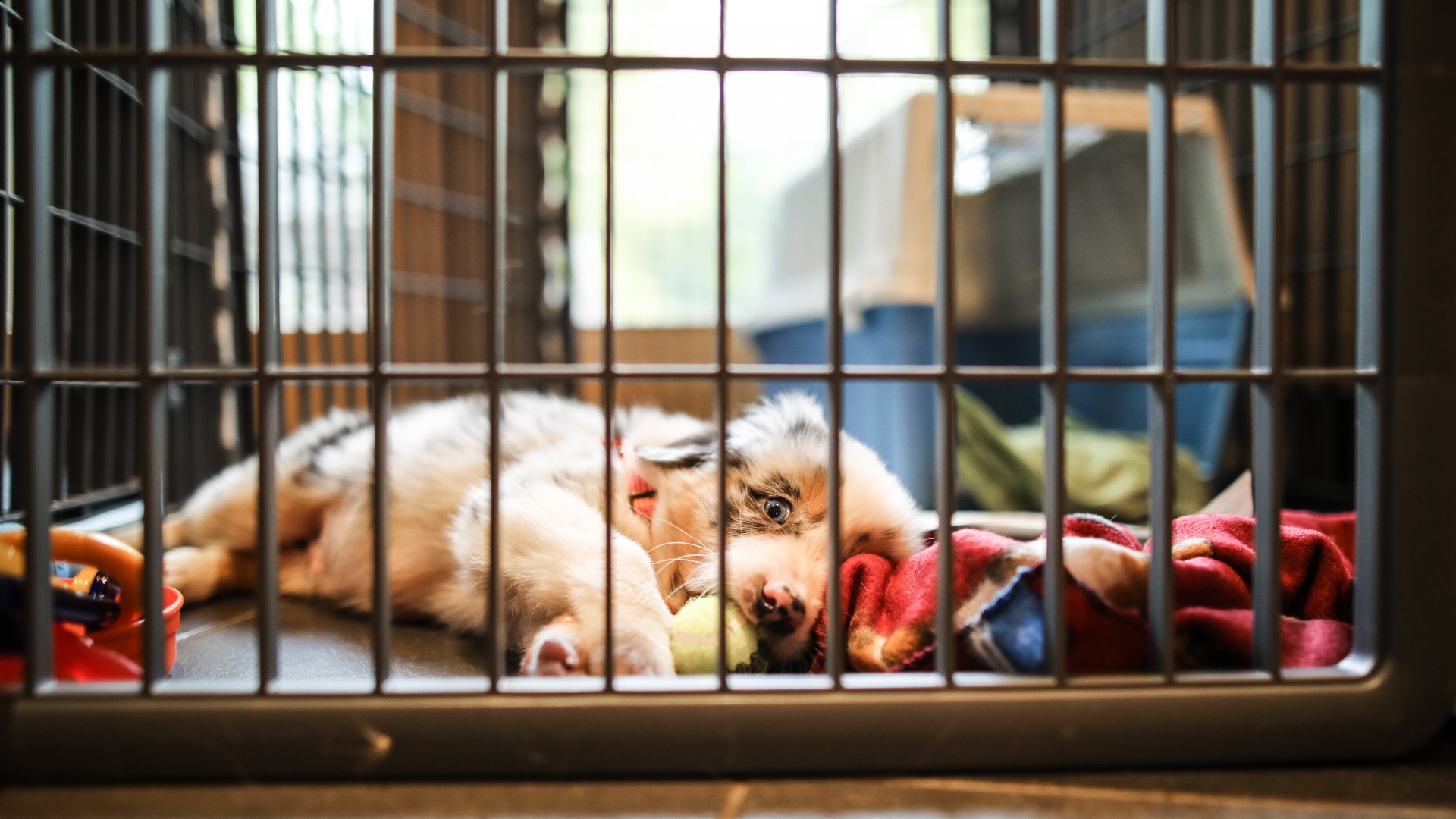Crate games for dogs to make training more fun
These fun crate games for dogs will ensure that time spent crated is an enjoyable experience for your pup

Having a few crate games for dogs up your sleeve can be a great way of keeping your fur friend occupied and entertained when they’re crated while also helping you to feel less guilty as a pet parent when you have work or other important obligations that require your attention.
Learning how to crate train a dog is an important first step on your journey as a dog owner. While it may seem harsh, crate training is good for your dog, providing them with a safe space when you’re not around so that they can feel secure in. It’s also brilliant for assisting with toilet training and can be comforting for pups struggling with separation anxiety.
Once you’ve invested in the best dog crate and created a comfortable and cozy environment for your beloved bundle of fluff, crate games can be useful both for assisting with the training process itself and also for ensuring your pup has plenty of mental enrichment and stimulation during the hours that they’re crated.
Whether you have a senior dog or a puppy who’s just learning the ropes, making time spent in their crate an enjoyable experience is essential. To help you do just that, Dr. Elizabeth Racine has put together this handy guide outlining the benefits of crate games and how you can incorporate them into your pet's routine.

Dr. Elizabeth Racine is a small animal general practice veterinarian with a bank of knowledge on all things pet health and wellness. She is especially interested in veterinary behavior, nutrition, and internal medicine. Dr. Racine also has experience writing content for the American Kennel Club, Merck Animal Health, Bayer PetBasics, Elanco, and CareCredit.
Making crate training fun
Crate training can be a stressful time for both dogs and dog owners. The crate is an unfamiliar space, and being confined can be a bit scary. Incorporating crate games into the training process can help your dog acclimate to their new space. The idea of crate games as a training tool is to show your dog that the crate doesn't have to be a scary place. In the very early stages of crate training, crate games can encourage your dog to practice going in and out of their new space. As your dog gets more comfortable in the crate, you can use more advanced games to encourage them in the training process. These games can help show your dog that being in the crate can be fun.
Below are some examples of games that you can incorporate into your crate training plan.
Fetch
Fetch is a classic game that most dogs are already familiar with. However, it can be easily adapted into a crate training game. While playing fetch with your pet's best dog toy, toss the toy into the crate. The toy in the crate provides an incentive for your dog to enter the crate on their terms. Getting your dog to walk into the crate willingly is one of the biggest hurdles of crate training. By making a game out of it, the experience becomes a little less daunting. Reward your dog when they go in the crate and bring the toy back to you. Alternate between throwing the toy into the crate and other parts of the room. As your pet becomes more comfortable going in and out of the crate, increase the frequency that you toss the toy into the crate.
Hide the treat
Treats are often used as motivation to get dogs to go into their crate. However, turning the crate treats into a game can provide additional mental stimulation and encourage your dog to spend time in the crate during the training process. Spread some of the best dog treats in different corners of the crate, so your dog has to explore the crate to find them all. If your dog has toys or other goodies in their crate, hide the treats under these objects. This makes your pet work a little harder to get their reward.
Use a treat you can break up into several pieces to prevent overloading your pet with calories. Hiding individual kibbles is also an excellent option for this crate game. As your dog gets more experienced with the crate, this is still a great game to help your pet pass the time.
Crate games for mature dogs

Even for experienced dogs, spending long hours alone in the crate can get old. In some cases, dogs who previously had no issue with being in the crate will start to resist going into their crate. For these dogs, crate games are great for adding some excitement to their routine. Crate games provide mental stimulation and can help your dog pass the time.
Food puzzles
Food puzzles come in a variety of different forms and are available at most pet stores. With food puzzles, dogs must use their problem-solving skills to get a treat. The best dog puzzle toys can also help keep your dog focused on something other than being alone. The activity will keep your dog stimulated and help them pass the time while you are away.
Food puzzles have different difficulty levels to meet your dog's needs. As your dog gets faster at solving the food puzzles, gradually increase the difficulty. Be careful not to pick a puzzle that is too tricky for your pup. If the puzzle is too complex, your dog may become frustrated and stop trying.
Sniff mat
A step up from food puzzles, sniff mats (also known as snuffle mats) provide mental stimulation and encourage your pet to use their nose and foraging skills. A sniff mat is typically a small mat made of strips of material attached to a plastic base. They come in a wide variety and can be purchased online or even made at home.
Before giving the mat to your dog, hide kibble or treats throughout the mat. Your dog must use their nose to find the treat and their problem-solving skills to retrieve it and get the reward. Depending on how elaborate your sniff mat is, this can keep your dog busy for quite some time. For dogs who tend to scarf down their food, this feeding technique can help slow them down. Consider hiding part of your dog's regular food in the sniff mat and making them work for their meal.
Keeping toys of any kind in your dog's crate always comes with some risk. When dogs become bored, they often chew or eat things they shouldn't. When using a sniff mat, it is essential to ensure your dog will not try to destroy the mat to get to the food. Before using the game in their crate, do a few test runs under supervision.
Get creative with crate training!
Crate training can be stressful, and experienced dogs often get bored being in their crate for long periods of time. Crate games can make spending time in the crate something your pet looks forward to. While many crate games are reward-based, these games also provide the mental stimulation that dogs need. You can also use these ideas and create your own crate games to incorporate into your pet's routine.
Enjoyed this piece and looking for more crate-related canine content? Then be sure to check out our guide to 'Dealing with separation anxiety: Dog crate solutions pros and cons.'
PetsRadar Newsletter
Get the best advice, tips and top tech for your beloved Pets
Dr. Elizabeth Racine is a small animal general practice vet covering all things pet health and wellness. Her special interests include veterinary behavior, nutrition, and internal medicine.
As a freelance writer, Dr. Racine has written content for major companies in the industry such as the American Kennel Club, Merck Animal Health, Bayer PetBasics, Elanco, and CareCredit. In her free time, Dr. Racine enjoys playing trampoline dodgeball, hiking with her beagle Dasher, and spending time with her three mischievous cats.
